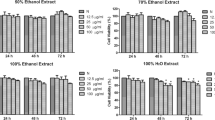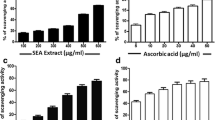Abstract
Purpose. To investigate the antiangiogenic effects of plant extracts and polyacetylenes isolated from Bidens pilosa Linn., which is a popular nutraceutical herbal tea and folk medicine in anti-inflammatory, antitumor, and other medications worldwide.
Methods. Anti-cell proliferation, anti-tube formation, and cell migration assays were used for the valuation of bioactivities of target plant extracts and phytocompounds against angiogenesis. Bioactivity-guided fractionation, HPLC, and various spectral analyses were used to identify active fraction and phytocompounds for anti-angiogenesis.
Results. We show that an ethyl acetate (EA) fraction of B. pilosa exhibited significant anti-cell proliferation and anti-tube formation activities against human umbilical vein endothelium cells (HUVEC). Bioassay-guided fractionation led to isolation of one new and one known polyacetylenes, 1,2-dihydroxytrideca-5,7,9,11-tetrayne (1) and 1,3-dihydroxy-6(E)- tetradecene-8,10,12-triyne (2), respectively, from the EA fraction. Compounds 1 and 2 manifested highly specific and significant activities against HUVEC proliferation with IC50 values of 2.5 and 0.375 μg/ml, respectively, however, compound 1 had a more potent effect on preventing tube formation of HUVEC than compound 2 at a dose of 2.5 μg/ml. Western blot analysis showed that both compounds upregulated p27(Kip) or p21(Cip1), cyclin-dependent kinase inhibitors, in HUVEC.
Conclusions. This is the first report to demonstrate that polyacetylenes possess significant anti-angiogenic activities and the ability to regulate the expression of cell cycle mediators, for example, p27(Kip1), p21(Cip1), or cyclin E.
Similar content being viewed by others
References
J. Folkman and Y. Shing. Angiogenesis. J. Biol. Chem. 267: 10931–10934 (1992).
J. Folkman. Angiogenesis in cancer, vascular, rheumatoid and other diseases. Nat. Med. 1:27–31 (1995).
F. Bussolino, A. Mantovani, and G. Persico. Molecular mecha-nisms of blood vessel formation. Trends Biochem. Sci. 22:251–256 (1997).
D. Hanahan. and J. Folkman. Patterns and emerging mechanisms of the angiogenic switch during tumor angiogenesis. Cell 86:353–364 (1996).
M. S. O'Reilly, T. Boehm, Y. Shing, N. Fukai, G. Vasios, W. S. Lane, E. Flynn, J. R. Birkhead, B. R. Olsen, and J. Folkman. Endostatin: an endogenous inhibitor of angiogenesis and tumor growth. Cell 88:277–285 (1997).
M. S. O'Reilly. Angiostatin: an endogenous inhibitor of angio-genesis and of tumor growth. EXS 79:273–294 (1997).
M. Yamaoka, T. Yamamoto, T. Masaki, S. Ikeyama, K. Sudo, and T. Fujita. Inhibition of tumor growth and metastasis of rodent tumors by the angiogenesis inhibitor O-(chloroacetyl-carbamoyl) fumagillol (TNP-470; AGM-1470). Cancer Res. 53:4262–4267 (1993).
V. Brower. Tumor angiogenesis-new drugs on the block. Nat. Biotechnol. 17:963–968 (1999).
P. Geissbergerand and U. Sequin. Constituents of Bidens pilosa L.: do the components found so far explain the use of this plant in traditional medicine? Acta Trop. 48:251–261 (1991).
H. W. Chin, C. C. Lin, and K. S. Tang. The hepatoprotective effects of Taiwan folk medicine ham-hong-chho in rats. Am. J. Chin. Med. 24:231–240 (1996).
R. L. Pereira, T. Ibrahim, L. Lucchetti, A. J. da Silva, and V. L. Goncalves de Moraes. Immunosuppressive and anti-inflamma-tory effects of methanolic extract and the polyacetylene isolated from Bidens pilosa L. Immunopharmacology 43:31–37 (1999).
T. Dimo, S. V. Rakotonirina, P. V. Tan, J. Azay, E. Dongo, and G. Cros. Leaf methanol extract of Bidens pilosa prevents and attenuates the hypertension induced by high-fructose diet in Wistar rats. J. Ethnopharmacol. 83:183–191 (2002).
R. P. Ubillas, C. D. Mendez, S. D. Jolad, J. Luo, S. R. King, T. J. Carlson, and D. M. Fort. Antihyperglycemic acetylenic gluco-sides from Bidens pilosa. Planta Med. 66:82–83 (2000).
M. M. Levin, V. S. Iasnetsov, A. I. Sul'zhenko, and N. F. Farash-chuk. Experience in treating alopecia areata with galenicals of Bidens triparta. Sov. Med. 10:135–136 (1974).
S. S. Mirvish, E. F. Rose, and D. M. Sutherland. Studies on the esophagus. II. Enhancement of [ 3 H]thymidine incorporation in the rat esophagus by Bidens pilosa (a plant eaten in South Africa) and by croton oil. Cancer Lett. 6:159–165 (1979).
S. S. Mirvish, S. Salmasi, T. A. Lawson, P. Pour, and D. Suther-land. Test of catechol, tannic acid, Bidens pilosa, croton oil, and phorbol for cocarcinogenesis of esophageal tumors induced in rats by methyl-n-amylnitrosamine. J. Natl. Cancer Inst. 74:1283–1290 (1985).
J. S. Chang, L. C. Chiang, C. C. Chen, L. T. Liu, K. C. Wang, and C. C. Lin. Antileukemic activity of Bidens pilosa L. var. minor (Blume) Sherff and Houttuynia cordata Thunb. Am. J. Chin. Med. 29:303–312 (2001).
Y. Sashida, K. Ogawa, M. Kitada, H. Karikome, Y. Mimaki, and H. Shimomura. New aurone glucosides and new phenylpropa-noid glucosides from Bidens pilosa. Chem. Pharm. Bull. 39:709–711 (1991).
L. Alvarez, S. Marquina, M. L. Villarreal, D. Alonso, E. Aranda, and G. Delgado. Bioactive polyacetylenes from Bidens pilosa. Planta Med. 62:355–357 (1996).
M. G. Brandao, A. U. Krettli, L. S. Soares, C. G. Nery, and H. C. Marinuzzi. Antimalarial activity of extracts and fractions from Bidens pilosa and other Bidens species (Asteraceae) correlated with the presence of acetylene and flavonoid compounds. J. Eth-nopharmacol. 57:131–138 (1997).
C. A. Zulueta, A. Zulueta, M. Tada, and C. Y. Ragasa. A diter-pene from Bidens pilosa. Phytochemistry 38:1449–1450 (1995).
M. G. Brandao, C. G. Nery, M. A. Mamao, and A. U. Krettli. Two methoxylated flavone glycosides from Bidens pilosa. Phyto-chemistry 48:397–399 (1998).
J. Wang, H. Yang, Z. W. Lin, and H. D. Sun. Flavonoids from Bidens pilosa var. radiata. Phytochemistry 46:1275–1278 (1997).
G. Rucker, S. Kehrbaum, H. Sakulas, B. Lawong, and F. Goelten-both. Acetylenic glucosides from Microglossa pyrifolia. Planta Med. 58:266–269 (1992).
E. A. Jaffe, R. L. Nachman, C. G. Becker, and C. R. Minick. Culture of human endothelial cells derived from umbilical veins. J. Clin. Invest. 52:2745–2756 (1973).
P. Boukamp, R. T. Petrussevska, D. Breitkreutz, J. Hornung, A. Markham, and N. E. Fusenig. Normal keratinization in a spon-taneously immortalized aneuploid human keratinocyte cell line. J. Cell Biol. 106:761–771 (1988).
R. Montesano, L. Orci, and P. Vassalli. In vitro rapid organiza-tion of endothelial cells into capillary-like networks is promoted by collagen matrices. J. Cell Biol. 97:1648–1652 (1983).
M. Jang, L. Cai, G. O. Udeani, K. V. Slowing, C. F. Thomas, C. W. Beecher, H. H. Fong, N. R. Farnsworth, A. D. Kinghorn, R. G. Mehta, R. C. Moon, and J. M. Pezzuto. Cancer chemopreven-tive activity of resveratrol, a natural product derived from grapes. Science 275:218–220 (1997).
J. A. Rose and C. M. Kasum. Dietary flavonoids: bioavailability, metabolic effects, and safety. Annu. Rev. Nutr. 22:19–34 (2002).
K. Igura, T. Ohta, Y. Kuroda, and K. Kaji. Resveratrol and quer-cetin inhibit angiogenesis in vitro. Cancer Lett. 171:11–16 (2001).
C. J. Sherr. G1 phase progression: cycling on cue. Cell 79:551–555 (1994).
K. H. Vousden. Switching from life to death: the Miz-ing link between Myc and p53. Cancer Cell 2:351–352 (2002).
L. Hengstand and S. I. Reed. Inhibitors of the Cip/Kip family. Curr. Top. Microbiol. Immunol. 227:25–41 (1998).
D. Goukassian, A. Diez-Juan, T. Asahara, P. Schratzberger, M. Silver, T. Murayama, J. M. Isner, and V. Andres. Overexpression of p27(Kip1) by doxycycline-regulated adenoviral vectors inhibits endothelial cell proliferation and migration and impairs angio-genesis. FASEB J. 15:1877–1885 (2001).
S. B. Parker, G. Eichele, P. Zhang, A. Rawls, A. T. Sands, A. Bradley, E. N. Olson, J. W. Harper, and S. J. Elledege. p53-independent expression of p21 Cip1 in muscle and other terminally differentiating cells. Science 267:1024–1027 (1995).
W. S. El-Deiry. WAF1/CIP1 is induced in p53-mediated G1 ar-rest and apoptosis. Cancer Res. 54:1169–1174 (1994).
Author information
Authors and Affiliations
Rights and permissions
About this article
Cite this article
Wu, LW., Chiang, YM., Chuang, HC. et al. Polyacetylenes Function as Anti-Angiogenic Agents. Pharm Res 21, 2112–2119 (2004). https://doi.org/10.1023/B:PHAM.0000048204.08865.41
Issue Date:
DOI: https://doi.org/10.1023/B:PHAM.0000048204.08865.41




